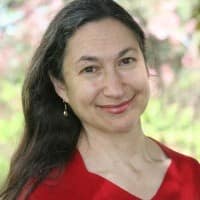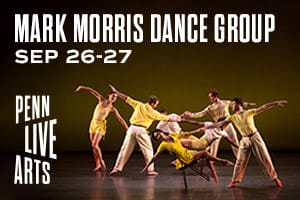Germaine Ingram, Philadelphia tap dancer, choreographer, performance artist and bearer of the city’s tap dance legacy, speaks with TD about her work and philosophy.
LB: Where do you see tap dance on the continuum from traditional to concert dance?
GI: For me, tap is a traditional form. How can you use that tradition to challenge people’s notions of how tradition can be represented? I think the drive to make tap a concert form has sucked some of the energy out of it. I think people are now finding ways to present tap in circumstances, including the “concert stage,” that don’t surrender what drives the tradition. The question is whether a space provides an opportunity for me to connect with an audience around the issues that are important to me. I am a tap dancer, but tap is not the end; it’s the means.
LB: I think of you as a collaborator with other artists.
GI: I love collaboration — the ways it challenges ideas. Even as a lawyer, I knew that being a sole practitioner was never an option. I always wanted colleagues who could support me, and who I could support.
I’m always thinking, here’s this idea. Who would be a good partner to help me chew on it? I’m working now on a piece commemorating the Battle of Atlanta, for July 2014 — 150 years after that Civil War battle. It was a turning point, helping assure that Lincoln was re-elected, that the war was winnable by the Union. I’m creating a performance piece with violinist Diane Monroe.
LB: Have you worked long-term with Diane?
GI: No, we’ve known each other a long time but it was only the beginning of 2013 when I said, okay, this is the year. I pulled her into the commission I had at the Kimmel Center [for Philadelphia International Festival of the Arts (PIFA)], and also for a site-specific piece that Leah Stein, John Phillips and I did at the Johnson House in Germantown. She has such a generous spirit and her performance skills are phenomenal, in classical and jazz genres.
LB: Do you follow a specific process in collaborations?
GI: I do a lot of research. Most of my work has to do with collective memory, history, social justice. I don’t feel bound to “historical fact,” but if people ask, where did that song or theme come from, I feel the need as an artist and a person interested in ideas to be able to respond with information and intelligence. A lot of my work has to do with making visible the invisible, giving voice to people who didn’t have voices. I think when enslaved Africans are written about, or write about themselves, it’s not just about them. These are experiences a lot of people shared. So my process is to do a lot of research and then go to my collaborators and say, let me share it with you. What questions do you have? What sparks your imagination? I think that is one of my gifts to a collaboration, to dig into something and say, “Tell me what ignites your passion in this research.”
LB: What has been the role of mentorship in your work?
GI: LaVaughn Robinson [Philly tap master] was an extraordinary mentor, not only as a teacher, but in the way he urged me to find my own voice, even if it veered from his. We would perform the same piece for years, and then all of a sudden I would realize, there’s a different way that I hear it. We were a generation apart: he was 20 years older. He came up hearing swing and I came up hearing bebop. For LaVaughn, bebop was jarring, especially as a dancer. He talked about his frustration when he’d show up at a club to perform and see John Coltrane on the bandstand. I also had an important mentorship relationship with Dianne McIntyre [dance and theater artist and director]. With Pew funding, she served as my artistic advisor for a project related to the practice of slavery at the President’s house. She was phenomenal — her humor, her directness, her experience as a choreographer, dancer, social activist, director. It’s been three years now since that project ended, and we continue to be friends and resources to one another.
LB: Do you enjoy when up-and-coming artists seek you out in mentorship roles?
GI: I love it so much that I created a context for mutual mentoring. With Pew funding, I created an artistic learning community in 2012 to 2013, for dancers who are interested in percussive dance and improvisation and who look to history, collective memory and social justice as content for their work. I asked Leah Stein to be my co-pilot. With the Pew funding we could have brought in just six more dancers. We invited about 20 people to apply, to respond to a few questions, and then had meetings for those interested. There were 10 people who completed the application process and I felt there was no way I could tell four of them to go away. So I found more money to support them all. That year was really phenomenal.
Early in the process, though, I realized that this notion that we were going to stick to a tight workshop schedule was impossible. People have other lives — they’re professionals, have families…. I concluded that I needed to go for an open space model and keep creating opportunities for people to come together. Sometimes three people, sometimes six or eight, sometimes all. Then I was asked to do a piece for PIFA. This was a great opportunity for the learning community, but I didn’t make it a forced march. I just said, anybody who wants to be part of it, step forward, and nine of the 12 did. Even those unable to commit supported the project in ways other than actually performing in the production.
As the project was ending people said, we ought to continue this. But as a perpetual thing, I think you set yourself up for disappointment because our best intentions are often undermined by life. So, when I realized how much documentation we had, I decided to make a website that was a kind of memoir. We worked with Ananya Chatterjea; also with Peter DiMuro on thinking about how sites speak to us, and with Dave Burrell [pianist, composer and improviser] on rhythm. These intensive workshops anchored our thinking and connection to one another. When I proposed the project, one thing I specifically didn’t want was an end product, a performance, or that kind of thing. But as it turns out, the PIFA opportunity brought us together as a community in ways that I don’t know anything else could have. We felt ourselves a community because we built it for a year; PIFA was in April 2013, toward the end of that period.
LB: Do you have any thoughts on the Philadelphia dance scene?
GI: It’s supportive, diverse. The lines become blurred here — not only among dance styles, but between dance and theater art, dance and other art forms. I think it’s wonderful. Dance USA-Philadelphia is a significant part of that because of the inclusive energy that Lois [Welk] and her staff have generated. And the fact is that Philadelphia attracts people from New York and other places because it’s an affordable place to live.
LB: Are you documenting your work, creating an archive or legacy?
GI: I recognize how important that is — for artists to be able to talk about work effectively. I’m so done with this notion that the work should speak for itself; for my work, I do extensive program notes so that diverse audiences, who come to the performance with different experiences, can feel they have a handle on it, they belong there. They might not read it beforehand; that’s fine. But they can take something away that they can go back to.
LB: Writing that kind of material is clarifying to the artist too.
GI: That’s one of the values of grant writing. I want to come away from a proposal feeling that the writing itself has been of value, regardless of the outcome. I have prevailed to some degree if that process has given me a clearer understanding of who I am as an artist, of my intentions and questions.
Ingram’s next project is with the 2014 Philadelphia Flamenco Festival; Ingram and Philly-area artists Eun Jung Choi and Meg Foley will work with Spanish flamenco artist Rosario Toledo on Tapas, Mar. 6-8, at Drexel University, Dance Studio-4th Floor, 3141 Chestnut Street.






